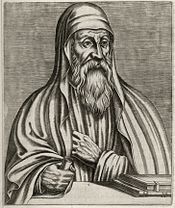
In Christianity, Christology, translated from Greek as 'the study of Christ', is a branch of theology that concerns Jesus. Different denominations have different opinions on questions such as whether Jesus was human, divine, or both, and as a messiah what his role would be in the freeing of the Jewish people from foreign rulers or in the prophesied Kingdom of God, and in the salvation from what would otherwise be the consequences of sin.

Original sin is the Christian doctrine that holds that humans, through the fact of birth, inherit a tainted nature in need of regeneration and a proclivity to sinful conduct. The biblical basis for the belief is generally found in Genesis 3, in a line in Psalm 51:5, and in Paul's Epistle to the Romans, 5:12-21.

In Western Christian theology, grace is created by God who gives it as help to one because God desires one to have it, not necessarily because of anything one has done to earn it. It is understood by Western Christians to be a spontaneous gift from God to people – "generous, free and totally unexpected and undeserved" – that takes the form of divine favor, love, clemency, and a share in the divine life of God. In the Eastern Orthodox Church, grace is the uncreated Energies of God. Among Eastern Christians generally, grace is considered to be the partaking of the Divine Nature described in 2 Peter 1:4 and grace is the working of God himself, not a created substance of any kind that can be treated like a commodity.

John McLeod Campbell was a Scottish minister and Reformed theologian. In the opinion of one German church historian, contemporaneous with Campbell, his theology was a highpoint of British theology during the nineteenth century. James B. Torrance ranked him highly on the doctrine of the atonement, placing Campbell alongside Athanasius of Alexandria and Anselm of Canterbury. Campbell took his cue from his close reading of the early Church Fathers, the historic Reformed confessions and catechisms, John Calvin, Martin Luther's commentary on Galatians, and Jonathan Edwards' works.

In Christianity, salvation is the "saving [of] human beings from sin and its consequences, which include death and separation from God" by Christ's death and resurrection, and the justification following this salvation.

In Christian theology, justification is the event or process by which sinners are made or declared to be righteous in the sight of God.

Limited atonement is a doctrine accepted in some Christian theological traditions. It is particularly associated with the Reformed tradition and is one of the five points of Calvinism. The doctrine states that though the death of Jesus Christ is sufficient to atone for the sins of the whole world, it was the intention of God the Father that the atonement of Christ's death would work itself out in only the elect, thereby leading them without fail to salvation. According to Limited Atonement, Christ died for the sins of the elect alone, and no atonement was provided for the reprobate. This is in contrast to a belief that God's prevenient grace enables all to respond to the salvation offered by God in Jesus Christ Acts 2:21 so that it is each person's decision and response to God's grace that determines whether Christ's atonement will be effective to that individual. A modified form of the doctrine also exists in Molinism.

Substitutionary atonement, also called vicarious atonement, is a central concept within Western Christian theology which asserts that Jesus died "for us", as propagated by the Western classic and objective paradigms of atonement in Christianity, which regard Jesus as dying as a substitute for others, "instead of" them.

The governmental theory of the atonement is a doctrine in Christian theology concerning the meaning and effect of the death of Jesus Christ. It teaches that Christ suffered for humanity so that God could forgive humans without punishing them while still maintaining divine justice. In the modern era it is more often taught in non-Calvinist protestant circles, yet also bearing in mind that Arminius, John Wesley and other Arminians never speak clearly of it. It is drawn primarily from the works of Hugo Grotius and later theologians like John Miley and H. Orton Wiley.

Unlimited atonement is a doctrine in Protestant Christianity that is normally associated with Amyraldism, as well as Arminianism and other non-Calvinist traditions. The doctrine states that Jesus died as a propitiation for the benefit of all humans without exception. It is a doctrine distinct from other elements of the Calvinist acronym TULIP and is contrary to the Calvinist doctrine of limited atonement.

The satisfaction theory of atonement is a theory in Catholic theology which holds that Jesus Christ redeemed humanity through making satisfaction for humankind's disobedience through his own supererogatory obedience. The theory draws primarily from the works of Anselm of Canterbury, specifically his Cur Deus Homo. It has been traditionally taught in the Roman Catholic tradition of Western Christianity. Since one of God's characteristics is justice, affronts to that justice must be atoned for. It is thus connected with the legal concept of balancing out an injustice.

The moral influence or moral example theory of atonement, developed or most notably propagated by Abelard (1079–1142), is an alternative to Anselm's satisfaction theory of atonement. Abelard focused on changing man's perception of God as not offended, harsh, and judgmental, but as loving. According to Abelard, "Jesus died as the demonstration of God's love," a demonstration which can change the hearts and minds of the sinners, turning back to God.

Gustaf Emanuel Hildebrand Aulén was the Bishop of Strängnäs in the Church of Sweden, a Lutheran theologian, and the author of Christus Victor, a work which still exerts considerable influence on contemporary theological thinking on the atonement.

Christus Victor is a book by Gustaf Aulén published in English in 1931, presenting a study of theories of atonement in Christianity. The original Swedish title is Den kristna försoningstanken published in 1930. Aulén reinterpreted the classic ransom theory of atonement, which says that Christ's death is a ransom to the powers of evil, which had held humankind in their dominion. It is a model of the atonement that is dated to the Church Fathers, and it was the dominant theory of atonement for a thousand years, until Anselm of Canterbury supplanted it in the West with his satisfaction theory of atonement.

In Christianity, the Devil is the personification of evil who rebelled against God in an attempt to become equal to God himself. He is depicted as a fallen angel, who was expelled from Heaven at the beginning of time, before God created the material world, and is in constant opposition to God. The devil is identified with several figures in the Bible including the serpent in the Garden of Eden, Lucifer, Satan, the tempter of the Gospels, Leviathan, and the dragon in the Book of Revelation.
Eastern Orthodox theology is the theology particular to the Eastern Orthodox Church. It is characterized by monotheistic Trinitarianism, belief in the Incarnation of the essentially divine Logos or only-begotten Son of God, a balancing of cataphatic theology with apophatic theology, a hermeneutic defined by a Sacred Tradition, a catholic ecclesiology, a robust of the person, and a principally recapitulative and therapeutic soteriology.

Penal substitution is a theory of the atonement within Protestant Christian theology, which declares that Christ, voluntarily submitting to God the Father's plan, was punished (penalized) in the place of sinners (substitution), thus satisfying the demands of justice so God can justly forgive sins making us at one with God (atonement). It began with the German Reformation leader Martin Luther and continued to develop within the Calvinist tradition as a specific understanding of substitutionary atonement. The penal model teaches that the substitutionary nature of Jesus' death is understood in the sense of a substitutionary fulfilment of legal demands for the offenses of sins.

In Christianity, sin is an immoral act considered to be a transgression of divine law. The doctrine of sin is central to the Christian faith, since its basic message is about redemption in Christ.

The recapitulation theory of the atonement is a doctrine in Christian theology related to the meaning and effect of the death of Jesus Christ.
Atonement is the concept of a person taking action to correct previous wrongdoing on their part, either through direct action to undo the consequences of that act, equivalent action to do good for others, or some other expression of feelings of remorse. From the Middle English attone or atoon, now meaning to be "at one", in harmony, with someone. Atonement "is closely associated to forgiveness, reconciliation, sorrow, remorse, repentance, reparation, and guilt". It can be seen as a necessary step on a path to redemption.











